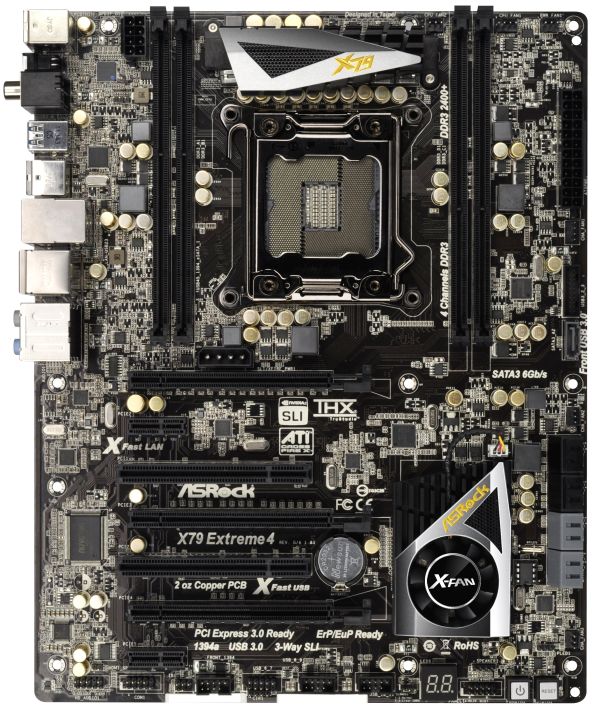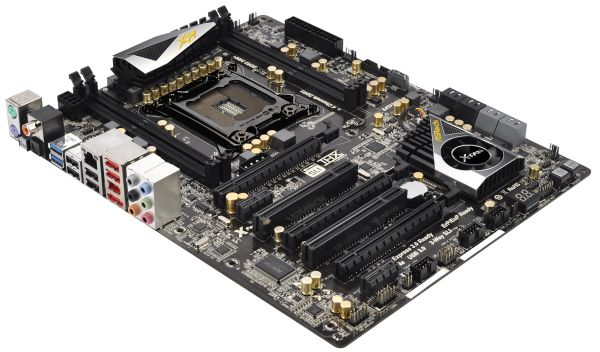ASRock X79 Extreme4-M and X79 Extreme4 Review – Sandy Bridge-E meets mATX
by Ian Cutress on December 9, 2011 12:00 PM EST- Posted in
- Motherboards
- ASRock
- X79
Overview
One of the first things people notice about the X79 Extreme4 is the price – a full size ATX board with the X79 chipset for ~$235 MSRP. As I mentioned in the X79 Extreme4-M overview, there will be demand for such cheap motherboards when more mainstream enthusiasts (rather than pure enthusiasts) may consider spending some, but not a lot, of money on a Sandy Bridge-E system.
With the ATX size, we can take full advantage of all the X79 features. In comparison to the X79 Extreme4-M, there is no lack of space for 40 PCIe lanes between the PCIe slots, there are more SATA 6 Gbps ports, the package has more to it (SATA cables, SLI connectors), and the board is tri-GPU possible. Some users may not like the fact that it has four memory slots (one per channel), but that is part of the reason why the board is cheaper than others. I will touch on this in the conclusion at the end of the review.
Performance on the whole was not too dissimilar to the X79 Extreme4-M, as expected. There were certain tests that this board would be slightly better on, and vice versa, but nothing outside the realms of statistical variance. Like the 4-M, despite the Realtek ALC898 audio, DPC Latency was a bit lacking compared to other X79 boards tested so far since release, probably due to BIOS configurations and maturity. The XFast LAN results however, as with Sandy Bridge P67/Z68 iterations, were a cut above the rest.
Visual Inspection
Perhaps it is just me, but I am starting to like the new ASRock styling. The black and gold angular PCH/heatsink style works quite well in my view of a top of the range motherboard, even if this is the more financially realistic end of X79 for the majority of users.
Despite the ability of having eight memory slots on X79, ASRock have decided to reduce the board price by only using one DIMM per channel, meaning four memory slots in total, here with quick release connectors. Given the abundance and low price of 4 GB DDR3 modules recently, and few power users requiring more than 16 GB of memory, using 4 DIMM slots is a good representation to save a few dollars on an overall system build perhaps. We will not be seeing all four memory slots on one side though, due to the pin layout of SB-E. As a result, the power solution to X79 boards are going to be squashed in the area above the socket itself – we see here ASRock have a heatsink covering the 6+2 phase VRM and chokes. A few vendors have this heatsink connected to a heatpipe and another heatsink below the socket, but again ASRock have left this out to save a few pennies.
Fan headers are in abundance, with a total of six. Two CPU headers and a PWR header on the top right, and a chassis header is underneath the 24-pin ATX power connector. Another chassis header is above the main block of SATA ports (which gets completely obstructed by any full length GPU in the first PCIe slot, and a third chassis header below the SATA ports (again, obstructed when a third full length GPU is in use).
Beneath the 24-pin ATX power connector is a USB 3.0 header, and a SATA 6 Gbps port, both provided by ASMedia controllers. The main block of SATA ports contains the typical ports from the Platform Controller Hub (four SATA 3Gbps in black, two SATA 6Gbps in gray), and another two SATA 6 Gbps provided via a controller. Next to this is the PCH itself covered in a black, gold and silver heatsink. As the heatsink is relatively small, ASRock have included a small fan connected to a small onboard header. This fan isn’t set to come on (by default) until the PCH reaches 50 degrees Celsius.
Despite this being one of the cheaper X79 options, we still get power/reset buttons, along with a two-digit debug LED useful for recognizing board issues. Aside from the usual array of headers on the bottom of the board, people will note the colorful use of gold capacitors on the board to tie in with the black/gold theme. ASRock argue in their marketing that these are premium conductive polymer caps – I hope they’re in some way premium, with this being X79.
In terms of PCIe layout, we have good and negative points. At the top is a 4-pin molex connector designed to give the PCIe extra power. For all intents and purposes, I found this largely useless, as two GTX580 GPUs ran quite happily without issue, as they already have their own power connectors and the PCIe specification should provide more power through the slot. It is also in an awkward place, for cable management inside a case. Nevertheless, we cannot really poke holes in the PCIe layout – at the top is a PCIe x16, x1, PCI, x16, PCI, x8, x1. I am thankful for the triple slot gap between the first two GPU x16 slots, and there is some space for any PCIe x1 card at the bottom. This is slightly different to what we normally see when PCIe lanes are at a premium – normally the x1 is at the top.
The back panel layout is identical to the X79 Extreme4-M. To quote, ‘From left to right, we see two PS/2 connectors, a clear CMOS button, a coaxial SPDIF out, an optical SPDIF out, two USB 3.0 ports, six USB 2.0 ports, gigabit Ethernet (Broadcom BCM57781), eSATA 6 Gbps, FireWire, and audio headers. For a board this price and on X79, we do not see much extra from what we would expect to be the standard.’












54 Comments
View All Comments
DanNeely - Friday, December 9, 2011 - link
A lot more of them do have reasons to be migrated than you'd think. Even 5 years ago I started seeing L shaped cards at the low end ( a tiny strip of PCB along the bracked, and a second for the PCI plug); chopping the 2nd half of the L cuts manufacturing costs by an amount that more than pays for the engineering over larger production runs.Devices that need larger PCBs but which have minimal bandwidth needs are an ever shrinking segment of the market. Even when total bandwidth isn't an issue the fact that PCIe bandwidth is dedicated instead of being shared means you no longer need to put as much hardware into buffering to avoid latency bursts when something else is using the bus more heavily.
Finally, once legacy PCI starts disappearing on a non-trivial fraction of boards total collapse from mainstream devices is inevitable. Once supporting PCIe becomes mandatory it's only a matter of time until redesigning the core chip on the card to be native PCIe instead of PCI and using a PCI-PCIe bridge chip becomes the cheaper option (probably with the next scheduled redesign). While they might initially maintain back compatability with a bridge chip going the other direction; however being doublely niche parts AGP gfx cards from 3 or 4 generations ago is probably a good comparison example. nVidia didn't make any at all, and the handful of ATI 3xxx/4xxx cards went at significant price premiums.
Eventually it'll end up like ISA; if you're willing to pay a large enough price premium (eg because the industrial/lab equiptment you're controlling costs thousands or millions of dollars to replace) there will be a handful of companies willing to sell you semi-custom boards at a large price premium and technology lag. The last time I looked I couldn't find ISA on anything newer than LGA775, until after intel finally pulls the plug on the last 775. That probably won't be for a while; if you look at their CPU database intel hasn't discontinued its embedded p4's yet, and probably won't file a while. IIRC they typically have contractual agreements to keep embedded parts in stock for a decade.
darckhart - Friday, December 9, 2011 - link
nope. still useful for pci graphics cards for troubleshooting video probs.Blibbax - Friday, December 9, 2011 - link
The differences in load power consumption might just demonstrate the margin of error on that test. Worth keeping in mind for other comparisons.The other possibilities are that the 5850s use a lot more power when they're a little bit hotter, and that the power circuitry on the M-ATX board is just awful under high load.
Concillian - Friday, December 9, 2011 - link
I was reading through the article and thought I had hit back instead of forward since I had read the page I was reading before.After finding all my marbles, I noticed that the article has two sets of Page 2 & 3. page order is 1, 2, 3, 2, 3, 4, 5...
hal74 - Friday, December 9, 2011 - link
I am always disappointed to find an article written by Ian. I know that I'll get an article written by someone who fails at plural vs singular when talking about a company and who doesn't come up with interesting comparison charts. Ian chose to throw in an E350 into the mix and didn't even add any comparisons with an x58, or any other core i7. Also, whats with fascination with older video cards in SLI?Is this seriously what people want in an article from Anandtech?
Spivonious - Friday, December 9, 2011 - link
Usually, I'll let grammar mistakes slide, but when I find multiple mistakes on a single page it really starts distracting me from the material.Can we get editors for the articles written by non-native English speakers?
Spivonious - Friday, December 9, 2011 - link
And "tenacity" is used incorrectly."...given ASRock’s previous tenacity when it comes to box bundling."
Does this make sense?
"...given ASRock's previous stubbornness when it comes to box bundling."
JonnyDough - Friday, December 9, 2011 - link
Yes. It does. Maybe your reading comprehension is lacking. The sentence means that ASRock will not budge when it comes to box bundling.Can we get some editors for the comments written by non-literate English readers?
Spivonious - Friday, December 9, 2011 - link
"3.2 GiB limit of 32-bit"*scratches head*
I thought 2^32-1 was 4GiB...
Aisalem - Friday, December 9, 2011 - link
using 32-bit you are able to address 4GB but unfortunately you will not be able to use whole 4GB in most of the 32-bit Windows installations, that also depend on the additional hardware you have.Now you shouldn't *scratches head*.